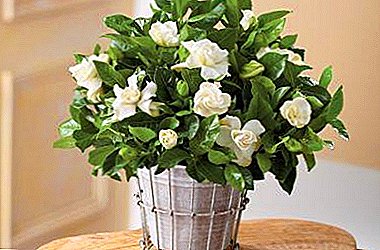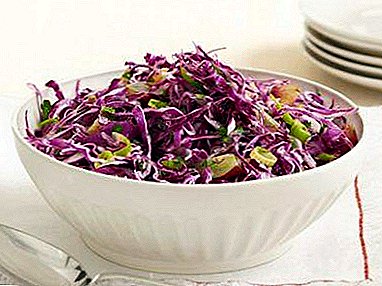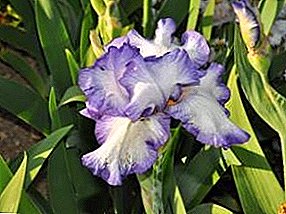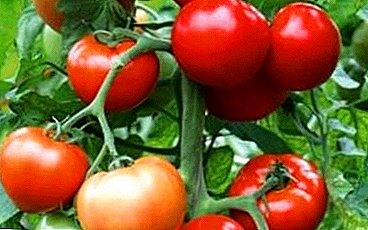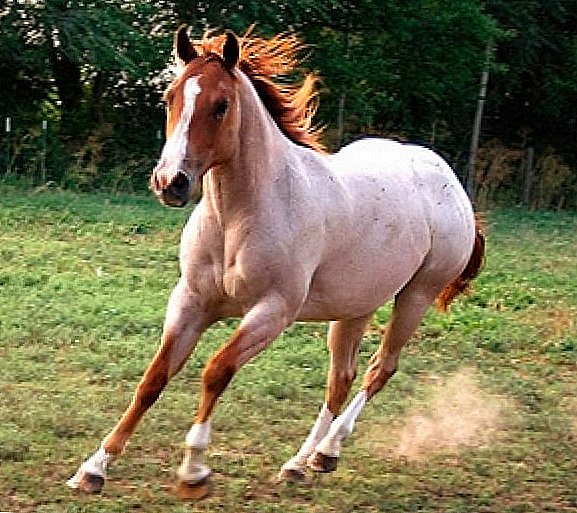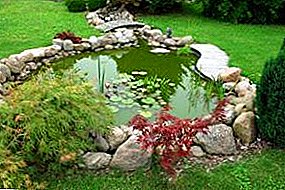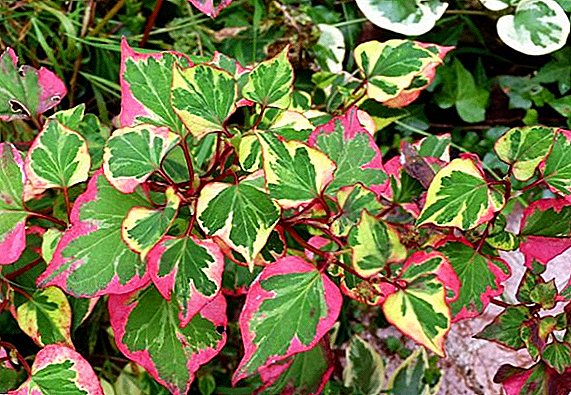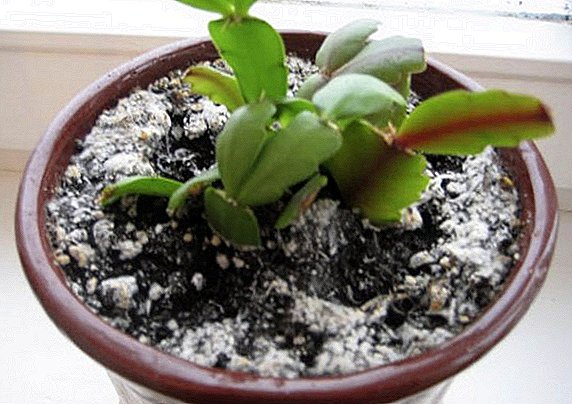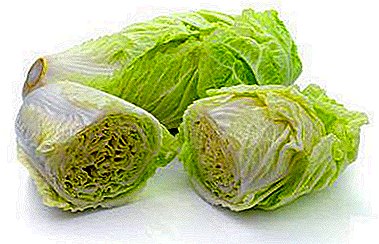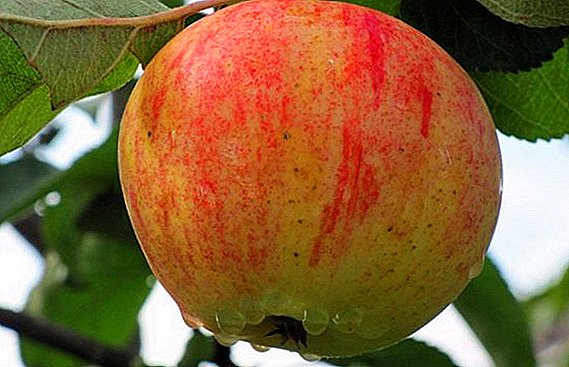 Very often, gardeners have a difficult choice of a wide variety of apple varieties, but still they often stop at universal ones, because they are not picky in their care and have an abundant quality crop.
Very often, gardeners have a difficult choice of a wide variety of apple varieties, but still they often stop at universal ones, because they are not picky in their care and have an abundant quality crop.
It is this sort of apple tree is considered "Orlinka".
Breeding history
This variety appeared in 1978 due to breeders NG Krasovoi, Z. M. Serova, E. N. Sedov, working in the Scientific Research Institute for Breeding Fruit Crops. For breeding "Orlinki" the varieties "First Salute" and "Stark Erliest Prekos" were crossed. The state test of the apple tree occurred 16 years after the creation of the variety.
Did you know? The oldest fruit-bearing apple tree in the world is considered to be a tree, which was planted in 1647 in America by Peter Stewesant.
Biological features
The apple tree "Orlinka" has a special description that will help to distinguish it from other similar varieties - it can be seen in the photo and read in the numerous reviews of experienced gardeners.
Tree description
Apple trees are vigorous, have a dense and rounded crown. The branches depart from the main trunk at a right angle and are placed quite compactly. The bark of the trees has a gray color and a rather smooth structure.
The shoots have a brown color, fairly thick, weakly mined and large. Large buds have a conical elongated shape, they are densely planted on the shoots.
Check out such apple varieties as Medunitsa, Bogatyr, Spartan, Mantet, Lobo, Melba, Uralets, Pepin Saffron, Currency, Orlik.For apple trees are characterized by large leaves of a rounded shape with a sharp end and large notches. The leaf is opaque, pubescent, wrinkled and slightly concave. Flowering tree abundant: flowers develop from large, elongated buds, they have a delicate pink color and a wonderful aroma.

Fruit Description
The fruits of the tree are one-dimensional, rounded in shape, medium in size - weigh about 150 g, but often reach 200 g. The skin of the apples is quite dense and glossy, has a light green color with a yellow color during harvest.
After full maturation, in the process of maturation, the fruits become yellow in color, and one side is covered with a pink blush. The flesh of the fruit is juicy, cream-colored, sweet with a slight sourness, apple seeds are brown and small.
Pollination
The apple tree "Orlinka" is a self-fertile and can be a good pollinator for varieties such as "Melba", "Papirovka", "Pear".
Gestation period
"Orlinka" refers to summer varieties of apples, and the fruits ripen in the middle - end of August. 
Yield
The yield of apple trees is quite high for the summer variety: it is about 170 kg per tree per season.
Transportability and storage
The transportability of apples of this variety is average, because the shelf life of apples is short - up to 1 month, provided that the temperature is correct from + 1 ° C to + 8 ° C. It is recommended to keep the harvest in a cool place in wooden boxes.
Important! Before you store the apples, you need to inspect the fruit for damage, to avoid premature rotting of the crop.
In order to improve transportability and prolong shelf life, fruits are treated with special chemicals, but it is important to understand that such drugs are not always harmless to human health.  To extend the storage time of fruits at home, you can use vermiculite, soaked with acetic acid, which is sprinkled on top of apples in boxes.
To extend the storage time of fruits at home, you can use vermiculite, soaked with acetic acid, which is sprinkled on top of apples in boxes.
Winter hardiness
Apple tree is characterized by winter-hardiness. It may not survive very low temperatures if the winter is not snowy, and in the middle latitudes of winter, the “Olinka” is not terrible.
Disease and pest resistance
The apple tree is considered to be moderately resistant to such pests as leafworms, a green aphid. The main pest, which often affects this variety, is scab.
For the prevention of diseases and pests, it is recommended to whitewash the stems with lime, dig up near-trunk circles, remove weeds and shoots in the near-stem circle, destroy fallen leaves, where the aphid eggs most often remain during the wintering period. 
Application
Fruit varieties of apple "Orlinka" suitable for use as a fresh or canned. Apples are often used to squeeze out juice, which can be drunk immediately, and poured into cans for storage after canning.
Jam or jam, which can also be made from "Orlinka", will also be a delicious dessert. But fresh consumption of fruits is considered the most beneficial for the organism, because they retain their beneficial substances, which are lost after heat treatment.
These apples are often used for avitaminosis, atherosclerosis, flu viruses of group A, and are also recommended for people who have had a heart attack.
Did you know? There is a fruit that looks completely like an apple, but inside it is like a tomato. In order to get this miracle of breeding, Markus Cobert spent 20 years.
Rules for planting apple seedlings
In order for the apple tree to feel comfortable, develop and bear fruit, it is necessary to take into account all the nuances when choosing a place, planting seedlings and caring for the plant. 
Optimal timing
The apple tree of this variety should be planted in the spring, when the snow has completely melted, and the possibility of frosts will be excluded, and the air temperature will be within + 15 ° C during the daytime, and the earth will already warm up a little.
You can also carry out the process of planting in the autumn. To do this, you need to choose the right time in early September, so that the tree has time to settle down and get stronger before the start of frost.
Location selection
When choosing a place for planting an apple you need to pay special attention to good air permeability and moisture content of the soil. This variety prefers to grow on loamy, sandy, leached chernozem.
If annual fertilization occurs, the apple tree will also take root on sandy soils. Also, the apple tree does not tolerate acidic soils, the acidity should be in the range of pH 5.5-6.0.  The tree prefers to grow in a well-lit place, because in the shade there is a chance of reducing the yield and sugar content of apples.
The tree prefers to grow in a well-lit place, because in the shade there is a chance of reducing the yield and sugar content of apples.
Also, the apple tree does not tolerate stagnant water, therefore, with the threat of flooding, it is necessary to provide for good drainage or landing on elevations. The groundwater level should be within 2.5 meters.
Site preparation
If planting of seedlings is planned in the spring, then preparation of the pit should take place in 2 weeks, and if in the fall, preparation should begin in a month. To do this, dig a hole 100x70 cm.  The earth is dug out and gradually scattered on two sides - on the prepared polyethylene film so that one side leaves part of the upper layer of the earth, and the other - the bottom layer.
The earth is dug out and gradually scattered on two sides - on the prepared polyethylene film so that one side leaves part of the upper layer of the earth, and the other - the bottom layer.
Inspect the prepared pit: if there are perennial roots, they must be removed. At the bottom of the pit it is necessary to dig up the ground or loosen it well with the help of scrap.
Seedlings preparation
Saplings before planting recommend soaking in water so that they recover the lost moisture. To do this, the root of the plant is kept in water for a day.
Inspect the roots of the plant: if there are damaged or dry affected parts of the roots, they must be removed with a sharp knife or pruner so that only healthy and whole roots remain. 
Process and scheme
The process of planting an apple is as follows:
- To begin with, organic fertilizers should be applied to the bottom of the pit, such as re-ripened manure or chicken droppings in an amount of 1 bucket mixed with ½ of the ground from the bottom layer.
- Then pour the rest of the soil into the center in the form of a hill on which to place the seedling so that the roots are freely located along the contour of the hill.
- Fill the planting pit with the top layer of earth, and compact it with your feet.
- Care must be taken that the root neck is 4 cm above the ground.
- Then it is necessary to tie the seedling to a support, which is fixed in the ground to a depth of about 1 meter.
- After the performed manipulations, the near-stem circle is watered with 2-3 buckets of water gradually so that the water is well absorbed.

Features of seasonal care for apple trees
Apple "Orlinka" has some features not only in the process of planting, but also in the care of the plant, so this fact must be taken into account in order to organize suitable conditions for this variety.
Soil care
The first two or three years, young seedlings need to be watered regularly. In the summer, watering is carried out once a month, using up to 4 buckets at a time.
Important! It is necessary to take into account the fact that when planting in sandy soil, apple trees should be watered with the same amount of water once a week.
When the apple tree grows up, each year the amount of water is increased - up to 3 years old, 3-4 water buckets are watered, then, starting from 4 years, the amount of liquid increases by 1 bucket. 
Mature apple trees require regular watering:
- before the buds bloom;
- when the tree has faded;
- one month before harvest;
- one month after picking apples;
- in the period of falling foliage.
In order for an apple tree to develop well, it is necessary to keep the okolostvolny circle constantly clean, that is, to remove weeds.
Given that the root system of a young apple tree is deep, we can remove weeds with a hoe or just pull it out with our hands.
In order to ensure the soil in which the root system of the apple tree is located, with good air permeability, it is recommended to regularly loosen the soil.  To do this, it is recommended to dig the ground near the apple in spring and autumn.
To do this, it is recommended to dig the ground near the apple in spring and autumn.
Mulching is recommended to carry out 2 times a year after loosening the soil. To do this, use straw, humus, leaves, peat. The layer of mulch should be 5 cm. Mulching helps to avoid drying out of the soil and the formation of a crust, retains the necessary moisture and contributes to a better breathability.
Fertilization
Carrying out the characteristic of caring for the apple "Orlink", it is important to pay special attention to the consideration of dressings. Young apple trees are fed with urea in early spring (10 liters of water, 2 tablespoons).
At the end of spring, it is recommended to apply foliar fertilizers, such as “Ideal” or sodium humate (for 1 bucket of water, 1 tablespoon of fertilizer). In early autumn, root-fertilizing is carried out with phosphorus-potassium fertilizers (for 1 bucket of water, 1 tablespoon of top-dressing). 
When the tree enters the fruiting period, you need to feed 4 times a year:
- In April, during the spring digging period, 0.5 kg of urea is poured into each tree.
- When the apple tree begins to bloom, it is necessary to add liquid superphosphate - 100 g, urea - 50 g and potassium sulphate - 80 g, which is infused for 7 days in 20 liters of water and placed under each tree.
- The next fertilizer application occurs when the apple tree fades. During this period, 100 g of nitrophoska and 2 g of potassium humate are infused in 20 liters of water.
- The last dressing is done when the entire crop is harvested. For fertilizers, a bucket of humus is used under each tree, 300 g of superphosphate and potassium sulphate.
Important! When dry fertilizers are applied, they should be embedded in the ground to the depth of the spade bayonet.
Fight against diseases and pests
To prevent pests and diseases from affecting the apple tree, preventive measures must be taken: a variety of chemicals are used for this purpose. 
The most common pests "Orlinki" are:
- moth;
- aphid;
- flower eater;
- sawfly;
- schitovka.
The most common diseases of the apple are:
- scab - a fungus that affects the plant due to excessive soil moisture and lack of oxygen in the soil. Bordeaux liquid and copper oxychloride are used to control scab;
- powdery mildew is a fungal disease that often affects a plant. To combat this disease, use drugs such as Scor or Topaz.

Cropping and crown formation
After a year after planting, the apple seedlings (in the second year) begin to form a crown. It is necessary to inspect the plants in the shtamba zone: in the presence of branches and strongly growing branches, part of the last year's growth is removed by a third.
Learn more about pruning an apple tree.This procedure is a stimulator for the growth of new shoots, which grow to the side and limit the growth of branches in height. Further, with annual pruning, it is necessary to remove old branches by a third in order to stimulate the growth of new young shoots and the development of flower buds on them.
It is also necessary to cut dry and diseased branches and shoots that grow vertically or inside the crown of the tree. After removing a part of the branches, it is necessary to close the cuts with a garden pitch.
Due to the correct and regular pruning, trees bear fruit well, and the duration of their life is significantly extended. 
Protection against cold and rodents
A frequent problem during the wintering of apple trees are rodent raids, which in the process of searching for food gnaw the bark of trees. It is necessary to take appropriate measures at the end of November, when the air temperature drops below zero.
In order to insulate the plant and protect the trunk from rodents, it is recommended to wrap the bottom of the trunk with a fir grove. It is necessary to tie the white branches with capron threads to the trunk to a height of about 1 meter.
You can use a metal grid, which is installed around the tree to a height of 1 meter, and bury it in the ground by 30 cm. To insulate the tree and protect it from frost, you can use roofing felt or sackcloth that is wrapped around the trunk.  Thus, to grow an Orlinka apple tree will not be difficult. The main thing is to make the correct planting and to provide high-quality regular plant care in order to get a bountiful harvest of tasty and healthy apples.
Thus, to grow an Orlinka apple tree will not be difficult. The main thing is to make the correct planting and to provide high-quality regular plant care in order to get a bountiful harvest of tasty and healthy apples.


